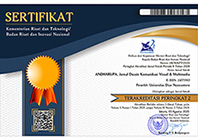Posmodernisme dalam Iklan Teh "Javana"
DOI:
https://doi.org/10.33633/andharupa.v3i02.1318Abstract
AbstrakPesatnya perkembangan periklanan Indonesia ditandai dengan banyaknya iklan di media televisi. Produk makanan dan minuman memanfaatkan iklan untuk saling bersaing dengan kompetitor. Minuman dalam kemasan menjadi populer khususnya teh yang paling banyak dikonsumsi selain air mineral. Beberapa produk teh dalam kemasan menampilkan iklan yang mengusung konsep kesegaran, aktivitas, serta kehidupan era kini. Teh "Javana" memiliki konsep iklan yang berbeda dengan iklan produk serupa. Iklan ini menampilkan perpaduan budaya tradisional dengan budaya kekinian yang dikemas dalam satu bingkai. Perbedaan konsep visualisasi dibanding dengan iklan sejenis serta penggunaan dua budaya di atas mendorong peneliti menemukan maksud di balik konsep iklan dengan menggunakan pendekatan posmodernisme, yang dibatasi pada idiom estetik: dekonstruksi, hiperrealitas, simulasi, intertekstualitas, kitsch, dan pastiche. Proses analisis dimulai dari pengamatan iklan audio visual, dilanjutkan penjabaran dengan mengambil beberapa elemen yakni gambar, teks, dan audio dalam posisi waktu yang ditentukan. Hasil analisis elemen-elemen digabungkan menjadi satu, kemudian disimpulkan. Hasil dari penelitian ini yaitu ditemukannya garis besar posmodernisme dalam iklan teh "Javana" melalui idiom-idiom estetik di atas, yang menciptakan kontradiksi dan paradoks terkait budaya tradisi dan budaya kini.Kata Kunci: budaya, iklan, teh, posmodernisme, idiom estetikAbstractThe fast growth of Indonesian advertising is shown by a lot of ads on television medium. The food and beverage products use ad to compete against the competitors. The beverage which included in Ready To Drink (RTD) category becomes popular, especially tea as the most widely consumed besides mineral water. Some bottled tea products show the ads with concept of freshness, activity, and contemporary lifestyle. “Javana†Tea has different ad concept with the similar products. This ad shows the blend of traditional with contemporary culture, which is packaged in a frame. Teh difference of visualization concept compared with the similar ads and the use of two cultures encourage the researcher to find messages behind ad by using postmodernism approach, which is restricted to aesthetic idioms: deconstruction, hyperreality, simulation, intertextuality, kitsch, and pastiche. Analysis process is begun from observe ad then breakdown it by taking some elements of image, text, and audio in the position of specified time. The results of analysis are combined into one and then concluded. The result of this research is the presence of postmodernism outline in “Javana†Tea ad through idioms aesthetic above, which creates contradiction and paradox associated with traditional and contemporary culture.Keywords: culture, advertisement, tea, postmodernism, aesthetical idiomsReferences
Agustina, D. 2015. Orang Indonesia Minum 2 Miliar Liter Teh Kemasan Setahun. Diakses dari: http://www.cnnindonesia.com/gaya-hidup/20151103151544-262-89179/orang-indonesia-minum-2-miliar-liter-teh-kemasan-setahun/, pada: 09 Desember 2016, 11.20 WIB
Baudrillard, J. 1983. Simulation. Semiotext (e). New York.
Darmawan, F. 2005. Postmodernisme Kode Visual dalam Iklan Komersial. Jurnal MediaTor, Vol. 7 No. 1, h 103-114. Bandung: Universitas Islam Bandung
Durianto, D., Sugiarto, Widjaja, Wachidin,A., & Supraktino,H. 2003. Invasi pasar dengan iklan yang efektif. Jakarta : PT Gramedia Pustaka Utama.
Hariyanto. 2004. Fenomena Parodi dalam Iklan Televisi Indonesia. Jurnal Bahasa dan Seni, Vol. 32 No. 1 h 112-126. Malang: Fakultas Sastra Universitas Negeri Malang
Hermawan, N. D. 2014. Efektivitas Iklan Televisi Tokobagus.com Versi “Mau Jual Mobil?†Pada Masyarakat Surabaya. Jurnal E-Komunikasi, Vol. 2 No. 1, h 1-12. Surabaya: Universitas Negeri Petra
http://badanbahasa.kemdikbud.go.id/kbbi/index.php
http://www.topbrand-award.com/top-brand-survey/survey result/top_brand_index_2016_fase_1
Jati, Y. W. 2016. Bright Award 2016: MNC Prediksi Belanja Iklan Tahun Ini Lebih Baik. Diakses dari: http://industri.bisnis.com/read/20160205/12/516517/bright-award-2016-mnc-prediksi-belanja-iklan-tahun-ini-lebih-baik, pada: 9 Desember 2016, 13.12 WIB
Jewler, A. dan Drewniany, B. L. 2004. Creative Strategy in Advertising. Wadsworth Publishing
KlikBekasi. 2015. Jumlah Stasiun Televisi di Indonesia Capai 394. Diakses dari: http://klikbekasi.co/2015/02/26/jumlah-stasiun-televisi-di-indonesia-capai-394/, pada: 6 Desember 2016, 09.38 WIB
Kotler, P. & Keller, K. 2007. Manajemen pemasaran (12th edition). PT. Indeks: Jakarta
Lubis, M. 2016. Pertumbuhan Belanja Iklan Menunjukkan Arah Positif. Diakses dari: http://www.nielsen.com/id/en/press-room/2016/PERTUMBUHAN-BELANJA-IKLAN-MENUNJUKKAN-ARAH-POSITIF.html, pada: 13 Desember 2016, 08.34 WIB
Piliang, Y. A. 1999. Hiper-realitas Kebudayaan. Yogyakarta: LkiS
Piliang, Y. A. 1999. Sebuah Dunia yang Dilipat. Bandung: Mizan
Piliang, Y. A. 2003. Hipersemiotika, Tafsir Cultural Studies Atas Matinya Makna. Yogyakarta: Jalasutra.
Pratiwi, I., dan Moeliono, N. 2014. Pengaruh Selebriti Endorser Maudy Ayunda Terhadap Minat Beli Produk Teh “Javanaâ€. Artikel Ilmiah, diakses dari: https://openlibrary.telkomuniversity.ac.id/pustaka/files/104153/jurnal_eproc/pengaruh-celebrity-endorser-maudy-ayunda-terhadap-minat-beli-produk-teh-â€Javanaâ€-studi-pada-masyarakat-di-kota-bandung-.pdf, pada 13 Desember 2016, 12.02 WIB
Pujiyanto. 2001. Periklanan. Malang: Universitas Negeri Malang
Purnomo, W. 2015. Persaingan bisnis teh kemasan makin hangat. Diakses dari: http://m.kontan.co.id/news/persaingan-bisnis-teh-kemasan-makin-hangat, pada: 13 Desember 2016, 11.52 WIB
Ritzer, G. 2010. Teori Sosial Postmodern. Bantul: Juxtapose Research and Publication Study Club/Kreasi Wacana
Russel, J. T., dan Lane, R. W. 2006. Kleppner’s Advertising Procedure, 14th Edition. New Jersey: Prentice Hall
Sugiharto, B. 1996. Postmodernisme: Tantangan Bagi Filsafat. Yogyakarta: Kanisius (Anggota IKAPI)
Suryani, T. 2013. Perilaku Konsumen Di Era Internet. Yogyakarta: Graha Ilmu
Sutrisno, M dan Putranto, H. 2005. Teori-Teori Kebudayaan. Yogyakarta: Kanisius
Zulkifli. 2014. Kritik Terhadap Perkembangan Posmodernisme dalam Senirupa Kontemporer Indonesia. Jurnal Bahas, Vol. XL No. 89, h 47-61. Medan: Universitas Negeri Medan
Downloads
Published
Issue
Section
License
Copyright (c) 2017 ANDHARUPA: Jurnal Desain Komunikasi Visual & Multimedia

This work is licensed under a Creative Commons Attribution 4.0 International License.
Authors who publish with this journal agree to the following terms:
- Authors retain copyright and grant the journal right of first publication with the work simultaneously licensed under a Creative Commons Attribution License that allows others to share the work with an acknowledgment of the work's authorship and initial publication in this journal.
- Authors are able to enter into separate, additional contractual arrangements for the non-exclusive distribution of the journal's published version of the work (e.g., post it to an institutional repository or publish it in a book), with an acknowledgment of its initial publication in this journal.
- Authors are permitted and encouraged to post their work online (e.g., in institutional repositories or on their website) prior to and during the submission process, as it can lead to productive exchanges, as well as earlier and greater citation of published work (See The Effect of Open Access).















